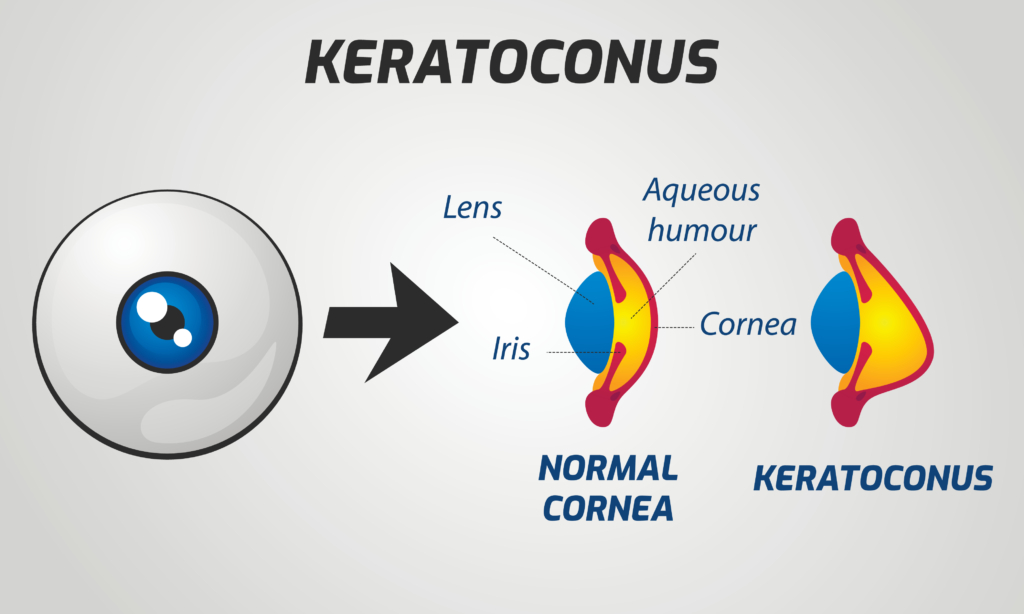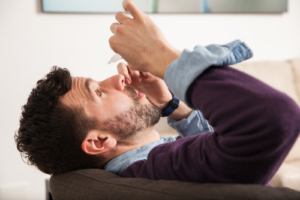What Does The Cornea Do?
The cornea is a critical part of the eye that helps you see. If you want to understand how your eyes work and how you’re able to see, it’s helpful to know what the cornea is and how it functions.
Keep reading to learn more about the cornea and find out how you can keep your eyes healthy!
What is the Cornea?

The cornea is the front part of the eye, which is transparent so that light can pass through. The cornea covers the pupil, iris, and anterior chamber.
It is made up of cells and proteins and has no blood vessels. The cornea receives nutrients from tears and oils that spread across the surface when you blink.
This tear film layer protects the eye from debris and germs. It forms a barrier that traps dust, dirt, and pollen between your eyelid and the cornea.
Then, your tears wash the debris to the side where they are blinked away, or you can see any particles and remove them.
There are five critical layers of the cornea:
Epithelium
The epithelium is the outside layer of the cornea. This smooth surface absorbs oxygen and has thousands of nerve endings.
The Bowman’s Layer
The Bowman’s Layer is the second layer of the cornea that is made up of robust and flexible collagen fibers in this see-through tissue. The Bowman’s Layer will scar as it heals from injury and can affect your sight when it scars.
Stroma
The stroma is around 90 percent of the cornea. It is mostly water and collagen.
Descemet’s Membrane
Descemet’s Membrane is a thin layer that prevents infection and injury from reaching deep into the eye and affecting the iris or pupil. It is made of collagen and endothelial cells and will regenerate if your eye is injured.
Endothelium
The endothelium is the last layer of the corneal. This is a thin layer of cells called endothelial cells that keep the cornea clear by pumping out fluid from the stroma.
The endothelium is irreplaceable. It will not grow back or heal if it suffers any damage due to trauma or disease. However, this layer can be replaced via a partial corneal transplant.
How Does the Cornea Work?
About 65 to 75 percent of your eye’s ability to focus is performed via the cornea. It is like the lens of a camera, allowing light into the eye.
Light hits the cornea, and it bends the light into the lens. The lens changes the light’s focus and transmits it to the retina.
The retina changes the light into electrical impulses that travel to the brain through the optic nerve. The brain then uses that information to translate and understand images.
What Conditions Can Affect Your Cornea?
You may have experienced discomfort in your cornea if you scratch the surface. This could occur if you rub your eyes and there is a tiny piece of sand under your eyelid.
The cornea can heal from minor issues like a scratch in as little as a few days. More severe injuries such as deep scratches can permanently alter the cornea. If you do suffer severe damage, this can reduce eye surface transparency and also affect your vision.
Keratoconus

Keratoconus is an eye condition that changes the shape of the cornea. A healthy cornea should be smooth and slightly rounded. For those with keratoconus, their corneas are longer and cone-shaped.
When the cornea is not smooth and round, it causes it to thin. This can make you more vulnerable to disease and injury. It may also cause double or blurred vision and light sensitivity.
There are various treatment options available for keratoconus, depending on how severe the disease has gotten. For patients with keratoconus in the early stages, eye doctors will often begin treatment with scleral contact lenses or hard contact lenses. Scleral contact lenses are special contact lenses that keep a healthy layer of tears on the eye.
This bathes the cornea with constant moisture while worn and protects the corneal surface from any irritation, severe dryness, and trauma. Another treatment that your ophthalmologist may consider is corneal cross-linking.
Corneal cross-linking is a procedure that helps keep keratoconus from progressing by strengthening the cornea using UV light and riboflavin to bolster the cornea’s collagen fibers. For patients with severe cases of keratoconus, a corneal transplant may be necessary to preserve their remaining sight.
Fuch’s Dystrophy
Fuch’s dystrophy occurs in about 2 percent of people who are older than 60. It is the most common corneal dystrophy in the country.
This disease slowly attacks the inner layer of the cornea, known as the endothelium, and causes blurred vision. Severe cases need advanced corneal transplants to replace this thin layer of tissue.
These transplants are called a DMEK (Descemet’s Membrane Endothelial Keratoplasty) or DSAEK (Descemet’s Stripping Automated Endothelial Keratoplasty). Rather than being full corneal transplants, these advanced transplants allow only the cornea’s inner layer to be replaced using a donor’s endothelial layer.
Corneal Ulcers
Corneal ulcers, or corneal infections, occur most frequently in people who wear contact lenses or have extremely dry eyes. These infections happen when bacteria, mold, or viruses damage the cornea.
Treatment for corneal ulcers includes antibiotics, antifungal, and antiviral eye drops. You may also need pain medication. You may lose your sight if you don’t seek treatment for these ulcers.
Dry Eye Syndrome

Dry eye syndrome describes patients who do not produce enough tears or the tears produced are low in quality. When your eyes are dry, it’s due to not having enough tears or oil in the tear film.
The tear film has three components: water, oil, and mucus. If any of these three components are missing, the tears produced will not lubricate the eyes.
Dry eye syndrome increasingly affects people who use their screens for more extended periods. Your blink rate goes down when you use digital devices like computers and phones, which reduces the amount of lubrication your eyes receive.
You may also experience dry eyes due to medication side effects, clogged meibomian glands, or naturally low tear production. Lack of tears can leave the cornea vulnerable to damage from irritants like dirt.
The corneal surface can develop ulcers and inflammation because of dry eyes. The condition may cause vision loss if it’s left untreated.
Corneal Erosions or Recurrent Erosion Syndrome

Scratches on the cornea cause corneal erosions. Recurrent cases can happen spontaneously.
If you scratch your eye by accidentally rubbing it hard, you have a higher risk of future abrasions. These scratches can cause blurry vision, sensitivity to light, watering, and red eyes.
Do you have concerns about how to keep your eyes healthy and safe? Request an appointment with the eye doctors at Eye Consultants of North Dakota in Fargo, ND, today!



